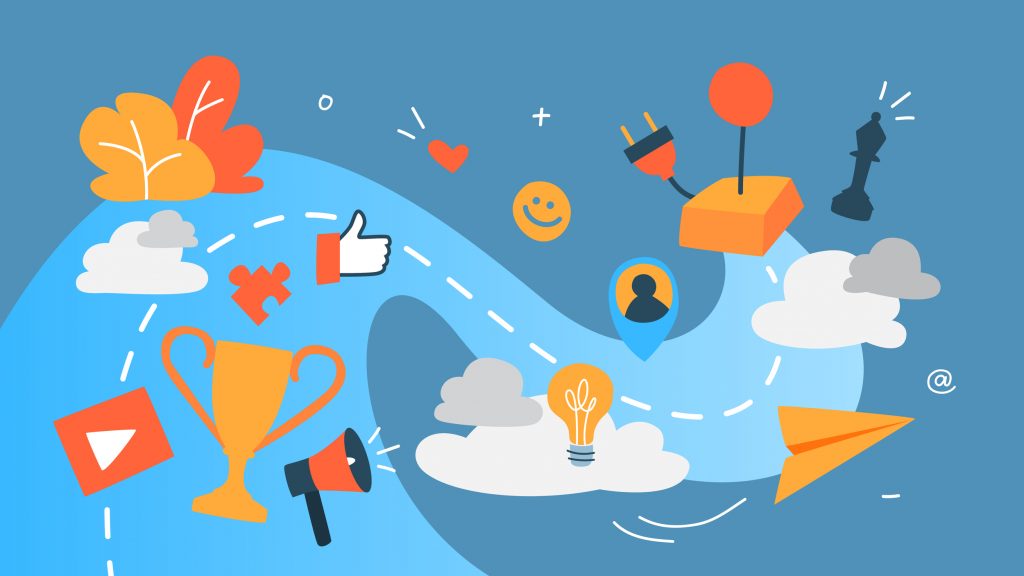Gamification in business? Yes. If you are hesitant about it, Apple and Amazon do it too. Would you consider them successful?
Gamification is a psychological theory that explores the idea of using game-related characteristics in a non-game environment. For example, you might have heard about the play way of teaching kindergarten kids. Instead of the traditional dogmatic approach, it includes the element of gaming in the learning process.
Does it give better results? If that’s what you’re wondering, the answer is yes. Research around this topic has proved that gamification increases engagement, concentration, and retention in the education field. But can it be applied to running businesses?
If you’re a skeptic, give us an opportunity to convince you otherwise. This article will discuss why businesses are using gamification and how you can implement it too.

How Gamification Works
When you’re playing a game (any game), there’s a task you’ve to complete. The task could be spread over multiple levels with mini-tasks, or each level of the game could be a final task of its own.
You’ll have limited resources and abilities. There will be dangers along the way of completing tasks. You’ve to understand how it works, observe the characteristics, and play to complete the task. When you do and move to the next level, you’ll be rewarded in terms of material, money, or game life.
You collect them and use them wisely to play more. If you misuse your resources unnecessarily, you’ll be left with nothing to accomplish your tasks.
It can be directly related to any business. The idea is to simulate the gaming scenarios in business to attract customers, drive user engagement, increase user experience, and move forward in the market.
Why are Businesses using Gamification?
Motivating and keeping the employees on their toes is not an easy task for businesses. If the employees are not motivated to work, businesses won’t be able to run.
To drive motivation, businesses use various gamification strategies. It directly results in gaining more leads from marketing, more sales from the sales team, and finally, significant revenue.
If you think about it, it is not a difficult concept to understand. It is the same as using gamification in the education sector. But in businesses, a game doesn’t mean an actual game. It means the implementation of gaming concepts into the business.
It might sound odd to many. But it is not a new concept. It’s been practiced in various forms for a long time. Let us give you an example.
In a car showroom, you might have observed the sales representatives flocking around you the moment you enter. Each of them would try to convince you that they’re the better sales executive.
Instead of having a rotation policy for new customers, why do showrooms encourage such actions? Because when the sales executives sell more vehicles, their incentives would also increase.
Now the concept sounds familiar, doesn’t it?
By dangling the incentives (which are rewards) in front of the sales executives, the showrooms keep everyone competing with each other. When they compete with each other, everyone tries to do their best. It removes mediocrity and grows the business.
It is not only for the benefit of employees but can also be applied to customers. How? Let’s discuss.

How is Gamification Incorporated?
1) Creating short-term bonus goals and hype around them
Amazon and Flipkart conduct big billion days on their sites. It is usually scheduled for a few days, and you can sense the hype it creates. You’re not going to get great discounts. But it creates so much hype for 3-5 days; it pulls everyone to buy something online.
There will be ads running on every possible marketing platform. It’ll trend on Twitter. New products will be launched. At the end of the sale, they’d have a hefty turnover. It is similar to the bonus rounds when we play a game.
Completing the level would give us a unique reward, and there’d be hype around such bonus rewards.
2) Creating braggable rewards
4Whatever your business is, you should create a ‘Unique Braggable Feature’ around your product. How? Let us explain this with an example.
When owning a mobile phone was considered an essential element, Apple made it a style statement. Having an iPhone was and is a braggable thing. People spend thousands of dollars to buy the iPhone even if they don’t need it, simply because it is an iPhone.
Apple thus created a loyalty market around it. Businesses should incorporate this boastable feature into their own. When your business has such a feature, it automatically transcends to your employees too. They would try to grow to fit into your ecosystem.

3) Reward everyone
It doesn’t mean you’ve to spend a fortune.
If you’re an Audible user, you’d know that the platform gives badges to the users.
For example: If you’ve listened to a book for straight 2 hours, it’ll give you a Marathoner badge. The badge doesn’t offer any monetary benefit, but it makes you feel that you’ve accomplished something. It gives you a morale boost. It is a gamification exercise.
Simulate these scenarios in your business. Reward and recognize every customer and employee. It’d make them feel heard, valued, and motivated. Basically, it is not going to cost you anything but,it’ll create loyalty and respect around your business.
Theoretical knowledge is fine. You’d like to employ these elements into your day to day corporate routine. But you’re not sure how to. Amplayfy can help you and your team to create interactive contents which will change the face of your organization.
Concluding Notes
Running a business is all about making the correct decision at the right time. In a way, it is like playing a game. Businesses have used gamification for a long time. What do you think about our opinions and if you have anything, please share with us.




